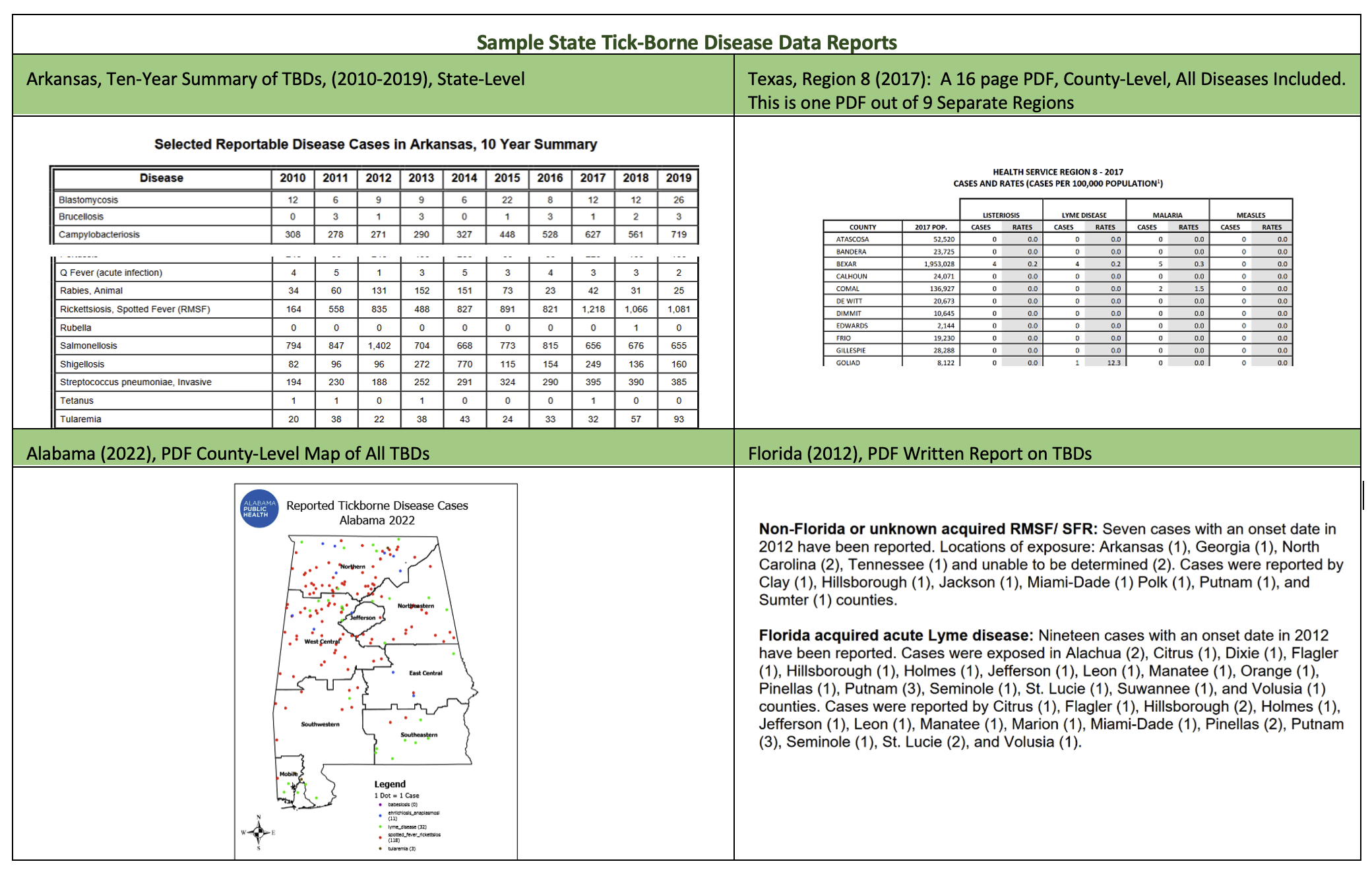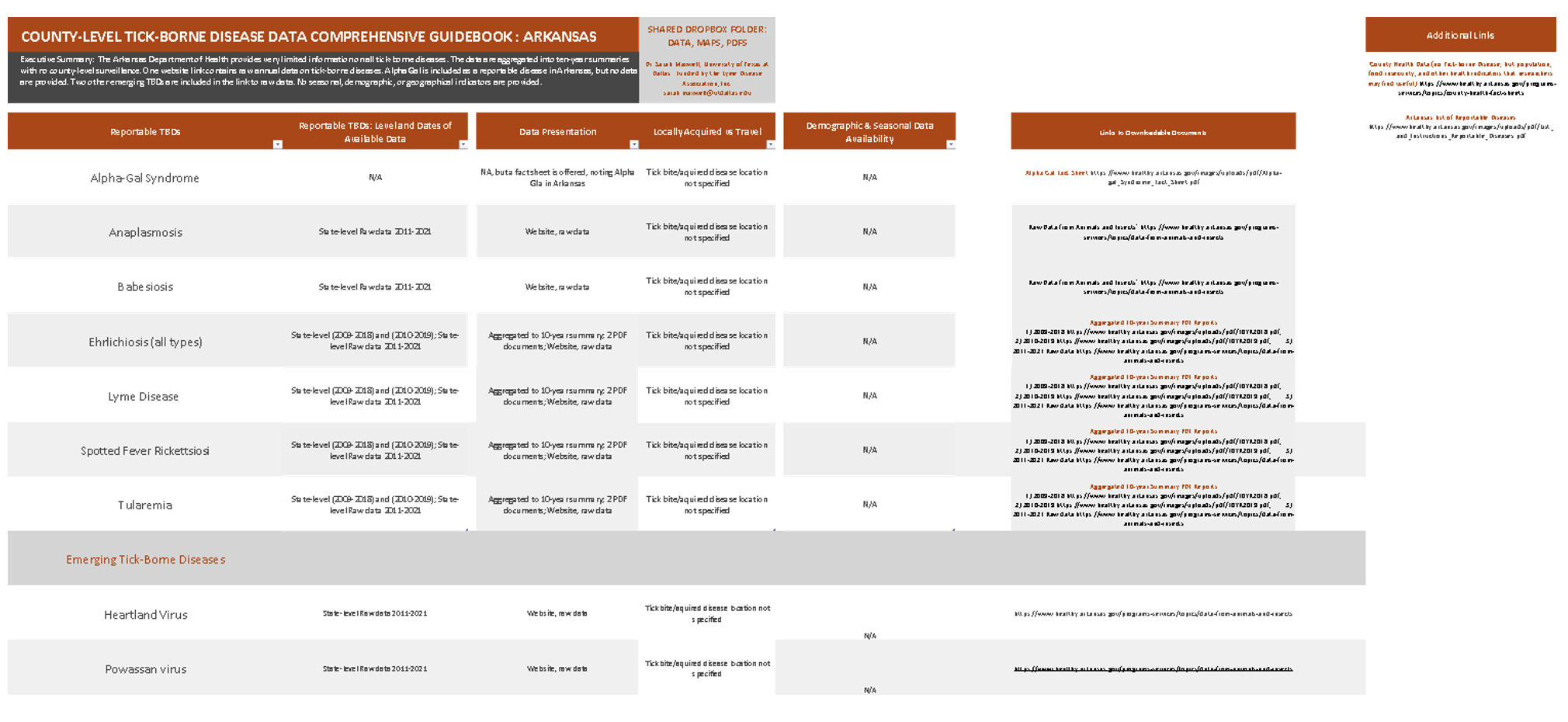
SHARE THIS ARTICLE:
Sarah Maxwell, Ph.D., May Awareness Guest Blog – County-Level TBD Data in the U.S.
May Awareness LDA Guest Blogger

Dr. Sarah Maxwell, Ph.D., Associate Professor, Public Health and Public Policy, University of Texas at Dallas. Dr. Maxwell is an expert on tick-borne disease surveillance and the use of triangulation and thematic mapping to assess tick-borne disease risk, particularly in perceived non-endemic areas and among vulnerable populations. Her recent work includes a grant from the Rita & Alex Hillman Foundation, titled Nursing in the Fields: Vector-borne Illness Prevention and Detection among Migrant and Seasonal Farmworkers. She has numerous publications on tick-borne diseases in high-impact journals. Dr. Maxwell served as a Fellow and continues her role as Faculty Affiliate at Boston University School of Medicine, Laboratory for Human Neurobiology. She is also a Research Affiliate, Center for Science, Technology, and Innovation Policy, George Mason University and founding member of Integrate, Communicate, Inform (ICI)-Vector-borne Disease Working Group.
County-Level Tick-Borne Disease Data in the U.S.: A Comprehensive Guidebook for Researchers
by Dr. Sarah Maxwell, Ph.D.*
Challenges Associated with Tick-Borne Disease Data
Navigating tick-borne diseases (TBDs) in the United States is analogous to traversing a labyrinth, filled with obscure pathways and blind alleys. These complex passageways found throughout state public health websites fail to provide researchers, public health officials, and medical practitioners with a quick reference to assess locally-acquired disease risk. Additionally, the Centers for Disease Control and Prevention generally do not provide county-level data on tick-borne diseases in the U.S., other than Lyme disease.[1] State public health departments offer limited TBD data, while the presentation of data is typically unhelpful at best. State reporting skips years; is inconsistently presented; or is presented in formats that make it very difficult to build a dataset, even for just one state.
For states with emerging tick-borne diseases, large states with varying eco-systems, and counties outside of the Northeastern U.S., TBDs other than Lyme disease are largely ignored. At the state level, data are often located in various formats (e.g., PDF or maps) and are inconsistently presented, particularly across years and among groups (e.g., age, gender). Knowledge of county-level disease presence is key to improved testing and diagnosis. A national data guidebook that documents all county-level TBD data is needed to assist medical practitioners in determining disease risk and travel-acquired TBDs, and to provide data access to TBD researchers so desperately need.
I therefore, reached out to the Lyme Disease Association, Inc. (LDA) with the goal to create a one-stop, quick-reference online, easy-access data guidebook. The overarching goal of this grant-funded initiative is to create a national, county-level guidebook on all tickborne diseases. The Data Guidebook will contain links to all state public health department pages related to TBDs, with a comprehensive summary of all available data. As I have begun this daunting task, however, I have also been downloading all PDFs, maps, written reports, and anything I can locate that will assist researchers to improve tick-borne disease surveillance and public health communication. These reports provide historical and fixed information so that links and changes to state public health department websites do not negatively affect the main goal, i.e., to secure TBD, county-level data in the United States over as many years as possible.
The products of this LDA-funded grant will allow researchers, epidemiologists, summer camps, schools, medical practitioners, and anyone requiring local information to obtain official data via a quick-reference manual. Researchers can quickly assess, for example, if a state offers downloadable data; if county-level data are available, and in what format; and what those data offer (see detailed description below).
Measurable Objectives Contained within the Data Guidebook Grant Proposal:
a) By March, 2024: A complete directory of state TBD state public health links and information will be entered into an excel file. Note: many states have data that are only publicly available through very detailed search criteria and may not appear on the main public health websites, underscoring the importance of a one-stop source for TBD data.
- Texas is an example, depending on year: Texas has changed its TBD reporting multiple times, resulting in data that are completely disconnected and not available to researchers in any single database. In 2017, Texas reported TBDs via PDF by region. In 2023, the website was updated to direct visitors in search of TBD data to the CDC. County-level data are no longer available. https://healthdata.dshs.texas.gov/# However, a search for specific diseases produces a dataset from 2000-2019, but does not provide county-level data. This muddled reporting structure requires a researcher to become a detective, and limits data availability to all TBDs.
b) By December, 2024: complete an analysis by state that is ready for preparation into a professional report. Examples of full report information include the following descriptive information for each state, allowing researchers and others to effectively locate and analyze TBD data:
- Executive summary of each state’s data and data availability
- County vs only state level data availability
- List of reportable tick-borne diseases (with county data)
- List of reportable emerging TBDs, if any
- Usability and presentation of data – e.g., maps, excel, Word, PDF (links provided)
- Available dates for each disease
- Does public health identify imported/non-locally acquired identified in maps or data? Y/N
- Data by age, gender, seasons Y/N and at the county or state level Y/N
c) By March 15th, 2025: a professional, 50-page report is prepared with one page per state. Information will be presented for quick reference by any researcher or end user, allowing open access, once and for all, to TBD county-level data in the U.S.
d) By December, 2025: publish a research note in a peer-reviewed journal outlining the report and presenting an overview and analysis of TBD public health data in the United States. This peer-reviewed research note will describe the state-of-the-states’ TBD data availability, presented in both written and summary form, similar to a health dashboard.
Preliminary Findings:
To fully comprehend the daunting task of mismatched data facing tick-borne disease researchers, visual illustrations are necessary. The grant launched in January, 2024, and as I now assemble the County-Level Tick-Borne Disease Data Guidebook, I can attest that it is worse than I first anticipated. States may or may not provide county-level data. If they do, it is often located in a PDF and, within that PDF, data may or may not be organized. In fact, many states present data in written paragraph form, rather than data that can be cut and pasted, and data across the board cannot be easily downloaded or converted to Excel. Additionally, within these PDFs are multiple other reportable/communicable diseases. A researcher might spend a full day pulling data from multiple links, PDFs, past reports, or even in Word documents, and most of these data are not necessarily located on one easy-to-locate website. Tick-borne diseases must be sorted out from other reportable diseases in the process. Historical data reports, if ever collected in the first place, often require significant sleuthing, digging, and searching.
Let’s face it, the United States tick-borne disease data situation is so inconsistent and complex, ChatGTP cannot even fix the problem. The complexities are shown below with examples of reports from selected states.

Sample Draft Data Guidebook: Arkansas
The Tick-Borne Disease Data Guidebook provides a summary for each state. The Excel file screenshot below highlights available data in Arkansas, one of the few states I have reviewed thus far that offers downloadable or cut-and-paste raw data that includes emerging TBDs. Good job, Arkansas! But, my request to you, Arkansas Department of Public Health, can you please start posting county-level data? With so many summer camps in Arkansas, along with countless state and national parks, historical sites, campers, backpackers, and hikers…along with notably high (and increasing) cases of diseases such as Tularemia and Rickettsiosis, Spotted Fever (RMSF), those who are unaware or are visitors to the state, may find themselves with flu-like symptoms and no explanation from their medical provider.
(Low resolution sample)

What Comes Next:
Will this grant fully solve the data problem? Sadly, no, but the Lyme Disease Association, Inc. has just funded the platform on which our collective work can now change the entire field of tick-borne disease research. We must continue to address the lack of public health information, and particularly, communication. What comes next is simple: The data will be held in separate files for each state, along with the Data Guidebook. The LDA will offer all collected information, along with the Data Guidebook entries online for anyone to access. From there, we, collectively, must develop a dashboard of all known TBDs at the county and state-levels across the United States. I am committed to this project, and the next step will be accomplished. Do you have ideas? Are you an institutional prospective partner? Feel free to reach out: [email protected] Let’s support the LDA and the University of Texas at Dallas in taking that next step so that disease surveillance becomes easy and accessible, and let’s work together so that patients can be diagnosed quickly and properly with local data.
[1] The CDC offers one county-level data set for selected tick-borne diseases from 2016-2019 https://www.cdc.gov/ticks/resources/Reported-Tickborne-Disease-Cases-by-County-of-Residence_2016-2019.xlsx
*Author Note: The opinions expressed in this Blog are personal opinions of author Dr. Sarah Maxwell only and do not necessarily reflect those of any other entity.





